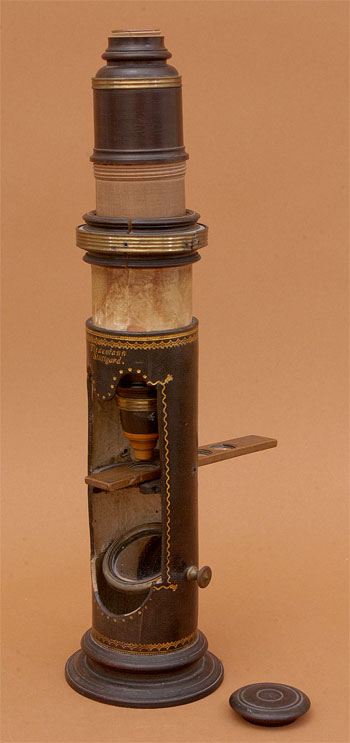 |
|||||
 |
 |
||||
 |
|||||
 |
 |
||||

This instrument in the Golub Collection is a cardboard and wood microscope with an ornate specimen stage and front opening. The microscope support is constructed of a cardboard tube glued to a fruit wood (probably pear) base. The wood base is stained dark brown to match the color of the tube above. The tube itself is covered in brown-stained leather and is decorated with gold stamping. Inset in the base is a circular plain mirror that pivots on two pins that pierce either side of the tube. Above the mirror is an ornately carved sample stage made of the same stained fruit wood as the base. Samples insert into a slot on the back of the base and lie on the stage. A brass spring clip holds the slide flat. There is one sample slide included with this instrument. The microscope support base is signed on the front in gold print: "Tiedemann Stuttgard".
The optical microscope is also made of cardboard and fruit wood. It consists of a body tube and an upper drawtube. The outside of the body tube is wrapped in vellum, presumably to provide friction when it is inserted in the base for focusing. The top of the body tube is crowned with a wood collar that is wrapped with a brass ring. Inserted into the body tube is the upper drawtube. It also is made of cardboard and wood. Optics consist of the standard three lenses: objective, field, and eyelens; all of which are biconvex lenses. The field lens is inserted in the lower end of the drawtube and held in place with a wooden collar. The eyelens is inserted in the upper end of the drawtube and held in place by the eyecup collar. The upper half of the drawtube is dyed brown. The eyelens can be covered with a turned wooden dust cap. Magnification is approximately 40x. Imaging is good, except for the predictable chromatic aberration. The microscope is approximately 33cm tall.
This microscope was instrument No. 75 of the Nachet Collection of Paris.
Featured 10/2012; 04/2022